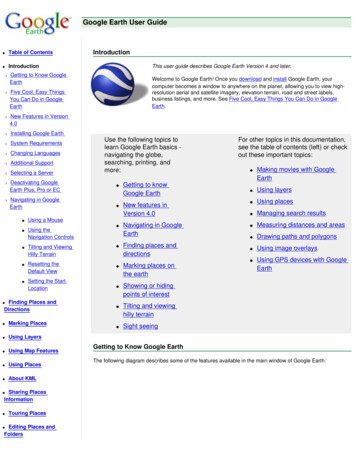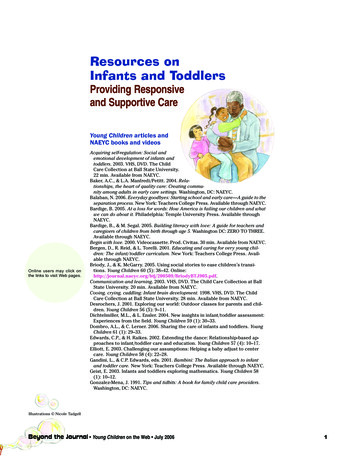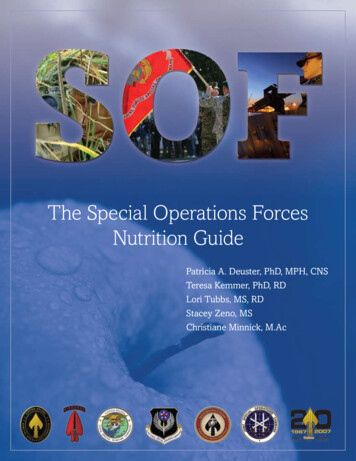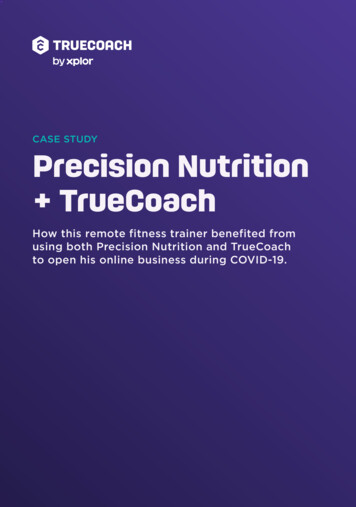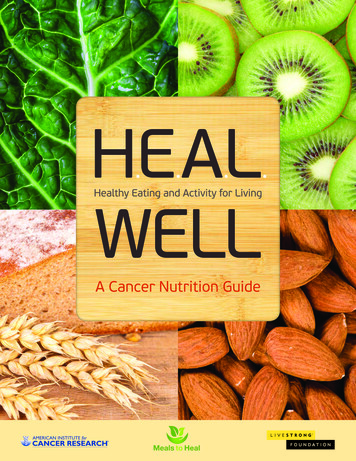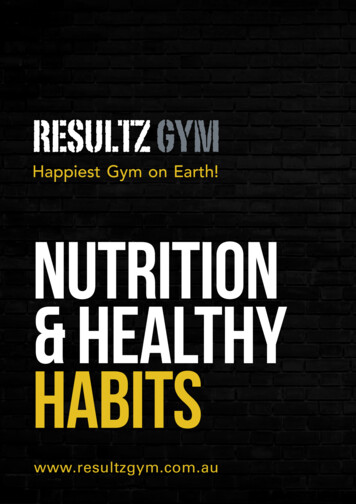
Transcription
Happiest Gym on Earth!Nutrition& HealthyHabitswww.resultzgym.com.au
Buildinghealthy habitsLong-term sustainability with yournutritional habits is the key that willenable you to maintain results long afterleaving Resultz Gym.The problem people face with shortchallenges and specific diets is that theyare often unsustainable and unrealisticto maintain long-term. This has thepotential to create habits around theyo-yo diet effect which is not a healthyapproach to longevity.We want you to build healthy habitsthat you will keep for life.So, we want you to absolutely commit tocreating healthier sustainable nutritionhabits long-term.
FOCUSING ON LESS ALLOWS YOU TO ACHIEVE MOREWe have all heard of baby steps before. Just like compounding interest adding minoralterations and habits into your eating strategies on a regular basis is a great way to ensurethat these easily achievable tasks compound to create long-term solid foundations.This is also where your 5 weekly action steps coming to play. I imagine that at least one orperhaps two maybe nutrition orientated and therefore will go a long way to create some newmodified habits around the way you consume your daily food3
SOME NUTRITION TIPS TO GET YOU STARTEDYour nutrition is a key factor to how you look, feel, and recover after exercise.Let me ask you a question. If you owned a formula 1 racing car and you wanted this car toperform to its optimal best would you put run-of-the-mill fuel in it from the servo?I’ll assume you answered no!It is the same with our own body. If you want to be in optimal condition then it makes senseto fuel yourself with foods that provide you with the correct vitamins, minerals andmacronutrient breakdown. If you are serious about understanding and learning the exactscience behind nutrition that will assist in creating a leaner body composition then enquireabout our nutrition program.Firstly, let me start by breaking down the 3 major macronutrientsthat are beneficial in every single meal you consume.PROTEINSCARBOHYDRATESFATS4
PROTEINSOur body is made up of protein, isso it makes sense that we shouldconsume it daily.Every meal should consist of high biologicalvalue (HBV) animal based protein such aslean meat, fish, poultry, egg and dairy or acombination of high plant based proteins forour veggo friends such as soy and legumes,combining them with nuts and grains tomake them complete. How much proteina person needs everyday will depend onweight, age, gender, training history, medicalhistory, injury and exercise type. Currentresearch indicates 1.2 to 2g/kg/ day of dietaryprotein is adequate to support metabolicadaptation, repair and for protein turnover.Higher intakes may be required for specificindividuals during intensified training or asignificant energy intake reduction. Proteindistribution and timing is just as importantas total daily protein intake. Post strenuoustraining sessions 0.25-0.3g/kg body weightshould be eaten in conjunction with adequatecarbohydrate to optimise muscle proteinsynthesis (MPS), with the remaining proteinintake spread across three to four meals.The foods below demonstrate HBV proteinsources containing 25g protein per serve:Weight in gramsFood117Beefsteak, fillet (or sirloin) raw, lean111Chicken breast meat raw no skin or bone125Beef minced, 90% fat free, raw (includes pork and lamb mince as well)111Smoked salmon85Turkey breast meat204Whole Eggs (4 large)116Kangaroo meat raw93Tuna tinned in spring water116Lamb lean meat700 mLMilk dairy (skin/reduced fat) 10g fat420Natural yoghurts (check nutrition label as brands differ)also contains 36 g carbohydrates200Cottage cheese low-fat760mlSoy milk, regular150Tofu, firm170Tempeh45Textured vegetable protein (TVP)250Lentils, cooked300Black beans, cookedNote: energy content of foods will vary5
CARBOHYDRATESCarbohydrates are a vitalmacronutrient found in a varietyof food and drink that provide ourbodies with fuel. The amount andtype of carbohydrates we eat willdetermine how your body respondsto training, fatigue, mood, andconcentration.Unfortunately, carbohydrate rich foodsreceive a lot of bad press so it is importantto understand which ones are beneficial forhealth and training and which foods shouldbe avoided or limited.Carbohydrate containing foods can becategorised into two categories,Nutrient Dense and Nutrient Poor. NutrientDense carbohydrate foods include fruits,non-starchy vegetables, starchy vegetables(potatoes, legumes), wholegrains (breadsand cereals), pasta, noodles, rice, [all thesefoods are also high in dietary fibre], milk andyoghurt. Energy density will vary betweenfoods however non-starchy vegetables areparticularly low in energy density and canbe eaten in larger volumes to aid in hungercontrol.Nutrient Poor carbohydrates are quiteenergy dense and some tend to also behighly processed. These include biscuits,cakes, lollies, chocolate, soft drink, cordial,fruit juice, crisps/chips, ice cream and sugar(including agave, rice malt, coconut – sugar issugar!).and increases blood glucose (sugar) levels.High GI carbohydrates (mostly your NutrientPoor carbohydrates) will increase bloodglucose levels more quickly and result in aquick spike of energy levels, followed by a‘crash and burn’ effect where you often feelmore tired, sluggish, and hungry! Often, wedon’t burn off this additional energy intakeand often leads to the excess carbohydratesbeing stored as fat. In contrast, Low GIcarbohydrate foods increase blood glucosemore slowly, at a steady state for a longerperiod of time. Allowing you to feel energisedand fuller for longer and without brain fog.Your body is using this carbohydrate asenergy for daily movement and activity andless will be stored as fat if any.Do not be fooled – GI isn’t black and white interms of being an indicator of what is healthyand unhealthy. White potatoes are a higherGI, but also contain various micronutrients aswell resistance starch when cooked, cooled,and reheated. Some dark chocolate may belabelled as low GI but this does not mean togo out and eat blocks of dark chocolate everyday! GI can be affected by fat and proteincontent as well as fibre, so be sure to usecommon sense in some instances!High GI foods also have their place in sportsnutrition strategies when used correctlyin and around training. Likewise, Low GIcarbohydrates are important in post highintensity and resistance training recoverynutrition to replenish muscle glycogen storesas well as aid in optimizing Muscle ProteinSynthesis (MPS).Understanding how carbohydrates aredigested can also assist in making betterchoices. This is where the Glycaemic Index(GI) comes in – it is a measure of how quicklyor slowly carbohydrate rich food is digested6
FATSFIBREFats are an important macronutrientto include daily in your diet toimprove your health, weight control,appetite, and inflammation.Dietary fibre is a key componentthat makes up a healthy diet andcan be used in conjunction withindividualised macronutrient intake toaid in changing or maintaining bodycomposition.Most people are aware of the different fatsbut often still get the balance incorrect intheir diet. Fats can be categorised as poly,monounsaturated, trans or saturated fats.Our healthy fats are our poly andmonounsaturated fats and can be a variety offoods including oily fish (salmon, sardines,tuna), sunflower & canola oil/spreads,walnuts, hazel nut and brazil nuts, soy beans/milk, chia/flax/sunflower seeds, and tahini.Monounsaturated fats are rich in foodssuch as extra virgin oil, peanut oil, avocado,almond/peanut and cashews.Additionally, our omega 3 polyunsaturatedfats are excellent for reducing the risk ofheart disease and stroke as well as improvingbrain health and reducing inflammation inthe body.The fats to reduce or avoid are our unhealthytrans and saturated fats which are typicallyfound in animal fat - butter, lard, fat/skinon meat. They are also commonly high incoconut oil, cream, milk, and full fat dairy.The easiest way to start introducing morehealthy fats into your diet is adding somenuts or seeds to meals or snacks, cookingwith canola or olive oil, and adding in oilyfish 2-3 times per week. The addition of a fishoil supplement may be beneficial; howeverthe dose is dependent on several factors andshould be discussed with your health careprofessional. More is not always best!More importantly fibre has a variety of healthbenefits that not only reduce your risk ofheart disease and diabetes but ensure ahealthy and happy gut! In short – it softensand moves your bowels, adds bulk and feedsyour good gut bacteria.The current guidelines for dietary fibre perday is 25g for women and 30g for men.More than 95% of Australians are notgetting enough vegetables, which we alreadymentioned above are an excellent sourceof fibre!Fear not, there are other foods that containfibre, these include oats, seeds, legumes,wholegrains, nuts, fruit skin, lightly ripebananas and products that state added fibre– always check the label!We need to keep our digestive system inshape as much as we need to move andexercise our body for better health. Startsimple by munching down on more fruit andvegetables daily and opt for more legumesand wholegrains at meal times.7
MEAL PORTIONS DISTRIBUTION AND FREQUENCYMany people will admit their mealportions are too big but what theymean to say is that the food portionson their plates are distorted.What I mean is meal size isn’t the issue, it’slikely the foods they are eating (high energydensity/nutrient poor) or the distribution ofmacronutrients is distorted. For example, asteak that takes up half the plate, followed byone third rice/potatoes and lastly a few beans,carrots and peas if you’re lucky .Instead try to aim for ¼ plate lean protein, ¼plate low GI carbohydrates and half a plate ofvegetables. This is a starting point to get yournutrient distribution more balanced.Eating more regularly is another way toensure you are fuelling enough across theday and not over-eating at meals. Aim to eatevery 2-3 hours as a guideline. Now there isa lot of misinformation and ‘bro-science’ onthe internet and social media that predictsthe next weight loss trend. Unfortunately, alot of these diets, although initially may leadto some weight loss, will likely end with yougaining the initial weight you lost, and thensome! Everyone is looking for a quick fix butare forgetting the fundamentals of nutrition –eat a balanced diet, limit energy dense foods,limit or avoid alcohol, eat mindfully. Studiesshow that people who skip breakfast or mealsstruggle with their weight and health relatedissues.Eating regularly allows you to eat smallermeals more often which will better supportyour health, appetite, metabolism and MPS.You actually burn energy when you eat – itscalled the Thermic Effect of Food (TEF) as suchyou are igniting your metabolism each timeyou eat. It may be four meals or six meals,everyone will find what works for them.You can eat more food – but it does not meanmore calories! This is where that half a plateof nutrient dense but low energy vegetablescomes into play. They fill you up, feed yourgut and allow you to feel satisfied withoutover doing it. Small habits over time lead tolong-lasting healthier behaviour change.For more individual advice and recommendations please consult withan accredited sports dietitian to support you with your personal goals.8
MEAL FREQUENCYMany people make the mistake of noteating regularly enough. There is a lotof bro-science out there on the WideWorld Web that will suggest fastingevery 3rd or 4th day will allow yourdigestive system to recover.Or that eating two meals per day willhelp you lose weight . And the listgoes on.Don’t even get me started on detoxificationdiets or meal replacement diets. Yes, chancesare you will lose some weight and you willalso destroy the metabolic environment thatis associated with building muscle growthand becoming fitter and stronger. These aregenerally short-term fixes and unsustainablelong-term.Ideally, you want to be consuming food tosupport your health, metabolism and musclerepair that is required after training. The moreregularly that you consume food the higheryour metabolism and therefore the moreefficient you become at utilising fat as fuel .Even when you are sleeping. Not to mentionthe general health benefits and increasedenergy levels of consuming food on a moreregular basis throughout the day.“But doesn’t eating more meals mean morefood and calories?”It means eating smaller meals more oftenand I will let you in on a little secret. Not allyour meals need to be solid. I often have 2liquid meals per day . That’s right, my mealis thrown in my bullet blender and turned intowhat resembles a thick shake. On occasions Ineed to consume with a spoon! This is still ameal that has all 3 macronutrients present thatI require. Easy to digest and a great way to getin my 5 or 6 meals per day.For those that skip breakfast or lunch youwill notice a huge difference if you startto eat smaller meals and more frequentlythroughout the day. If you currently have 3meals then aim for 4. Once you get to 4 andare comfortable for some time perhaps throwin a liquid meal and see how 5 meals per dayworks out for you. Meal frequency is alwaystesting and adjusting to see what works bestfor you. The science suggests that 6 meals perday is optimal to create a fantastic metabolism.Small modifications over time is certainly agreat way to establish healthier eating habits.Every opportunity you have to consume ahealthy meal will allow you to burn fat, buildmuscle and accelerate recovery from exercise.PROFESSIONAL TIPMeal frequency takes priority above all else. When in doubt about meal size makethem smaller and do your best to get your meal construction correct.9
MEAL EXAMPLESOmelette 2-3 large eggs 1-2 slices of wholegrain orsour dough bread 2 handfuls of vegetables e.g. mushroom,onion, zucchini, spinach, tomato, capsicum ¼ avocado or omega 3 enriched spreadThis is a quick and easy meal. Pan-fry thevegetables on medium heat and then set aside.Crack the eggs and whisk together with a dashof milk if needed. Spray the pan and turn tohigh heat, pour the egg mixture in and coat thepan evenly. Cook for 2 minutes, then reduceheat slightly. Once the omelette starts to bubbleits time to add the veggies back to one side.Use a spatula to test the edges of the omelette,once they are moving without resistance flipone side on top of the veggies. Cook for afurther 3-5 minutes.Use the spatula to remove the omelette fromthe pan and add to plate. Toast bread andenjoy with a bit of avocado or omega 3 spread!Season with a little salt and pepper if desired.Enjoy!TIPS Not enough eggs – add some leftover chicken or ham Add a side salad instead ofcooked vegetables Omelette fails? Make scrambledeggs instead, no one will know!10
HEALTHY PLATE GUIDELearn to build your plate following the Healthy Plate Guide, focusingon redistributing what is on your plate to include lean protein, low GIcarbohydrates, mostly vegetables or salad and a drizzle/sprinkle of healthy fats.1. PALM2. CUPPED HAND3. FISTPalm size - lean proteinPalm to fingertip - fishFemales/recovery days Low GI carbohydratesMales/high intensitytraining days - Low GIcarbohydrates4. TWO HANDS5. THUMB SIZENon- starchy vegetablesHealthy fatsYou plate portion will also largely bedependent on age, gender, whetheryou’ve trained and your health and bodycomposition goals.Snacks are a great way to make sure we areeating regularly and getting adequate nutritionin. This can be as simple as making sure youhave your two serves of fruit per day!Learning to cook healthy meals is notdissimilar to exercise. Most of us don’t knowwhat we are doing to begin with and oftencopy what our friends or family do. Startwith meals and recipes you are familiarwith and practice reducing your proteinand carbohydrate portions and increase theveggies. Following recipes can be a great wayto get started to give you ideas and allows youto trial and error certain combinations, flavoursand increases the variety of foods you eat.Doesn’t matter if you don’t get it right or followit exactly, do your best and you will learn whatyou like along the way. The important thing iscreating new healthy habits like more homecooked meals, meal prepping and eating avariety of foods – eat the rainbow!11
SOME FOODS AND BEVERAGES TO AVOID OR MODERATE Most processed/packaged foods (typically energy dense and nutrient poor) Processed meats such as sausages, chicken nuggets, pies, salami Soft cheeses including brie, camembert, blue (very high in saturated fat and little to noprotein or calcium) Sweet biscuits or cookies, cakes, chocolate, ice cream, lollies Soft drink, cordial, energy drinks Alcohol – it is a toxin and your body will prioritise removing it from your body andinstead store fat and also reduces MPS optimisation Excessive amounts of high sugar/salt sauces and dressings Take away foods including chips, burgers, pizzas, etcFoods are neither good nor bad and should not have any moral agenda. Some food is simplymore nutritious than others. It is important to mostly eat foods that are nourishing and fuelthe body that benefits our health and to limit or avoid foods which do not. The aim is to havethe foods you enjoy that aren’t that nutritious (it could be chocolate, soft cheese or wine!) insmall amounts and not so often so that you truly appreciate the taste, flavour and indulgenceof having them. You eat it, you enjoy it and move on – no guilt included!There are numerous layers and factors that impact a person’s nutrition choices and eatingbehaviours. These behaviours took years to form, so it would be naive to believe that theycan change overnight. It is about replacing those not so good choices with better choicesover and over again, which will lead to more empowering nutritional habits. The hardest partis starting, but once the wheels are in motion and you start to see a change in your energylevels throughout the day it makes it very difficult to go back to your old eating habits. Youwont need to do it alone as you will have us supporting and encouraging you every step ofthe way! But ultimately it is up to you!!12
This nutrition and healthy habits guide is not for distribution and may only be shared withthe permission from the following people/organisations.Resultz GymMathew Skatee: mat@resultzgym.com.aum: 0414 474 040Renee MartinSports Dietitiane: renee@resistancess.comm: 0415 357 144
Happiest Gym on Earth! www.resultzgym.com.au Nutrition & Healthy Habits. Building healthy habits Long-term sustainability with your nutritional habits is the key that will . We have all heard of baby

